Positive Health Online
Your Country

Gokhale Method™ for a Pain-Free Back
listed in back pain, originally published in issue 213 - April 2014
Physician, Heal Thyself
If you are a health and wellness professional, sitting, standing, bending and lifting likely constitute a large part of your work life. Are these positions comfortable for you or do you experience the same aches and pains that your clients seek help with? Do you have concerns about how age and time will affect your future ability to work, live and enjoy life? If so, you are not alone.
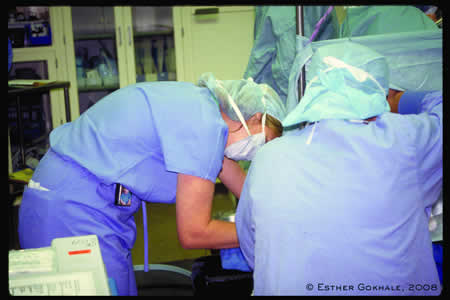
The anaesthesiologist pictured above, for example, suffers significant back pain.
Back pain, at the top of the list of musculoskeletal problems, is a very democratic affliction. According to BackCare, the UK national charity for back pain, almost half the adult population of the UK (49%) report low back pain lasting for at least 24 hours in the year, and it is estimated that four out of every five adults in industrialized countries will experience it at some stage in their life. Though back pain peaks in adults of 35 to 55 years of age, it is increasingly common among children and adolescents. Interestingly, in about 85% of all cases, no clear pathology can be identified, and conventional medical wisdom finds it very difficult to identify a single cause for lower back pain.
While it is good news is that most back pain resolves within six weeks, the not-so-good news is that such bouts often recur, developing into an ‘intermittent’ or chronic condition. No surprise then that NICE (National Institute for Health and Care Excellence) guidelines cite a report saying that 62% of people still experience pain one year after a first episode of back pain. Doctors offer symptomatic relief with anti-inflammatory and pain-killing drugs. A range of musculo-skeletal treatments are available which may get people out of trouble in the short term and also help with long-term management. However, sufferers often feel that these responses fall short of getting to the root of the problem.
A large number of people, having tried numerous approaches without seeing long-term results, give up on even looking for solutions and accept pain as a part of the natural course of ageing, work stresses, sedentism, or being inadequately adapted to bipedal living. These people constitute a silent contingent of the population that has downward adjusted their activities, expectations, and enjoyment of life. They don’t even show up in our statistics on pain.
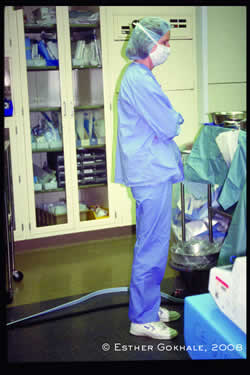
I photographed her at work as part of my research for the Neurosurgery Grand Rounds I presented at Stanford in 1998. As she held her back and winced with pain, she remarked “I’m looking forward to when I retire and won’t have to bend anymore.” What a sad, low bar this signifies! This physician is a young woman, a well-trained medical professional, and the only way she can see herself out of pain is to wait until retirement and quit bending. Such a lacking solution and one that she will have to wait decades for. She sees no other options that hold promise on her radar.
For those of us living in the industrialized world the experience of musculo-skeletal pain, malfunction and joint degeneration is becoming more common. We rely increasingly on orthotics, joint replacements, disability aids and pain medication, as we become increasingly resigned to the inability of our bodies to find their own solutions. Ailments that used to be associated with old age in our culture, such as back, hip, knee, neck, shoulder and foot problems, are affecting people at an increasingly young age. In this article I would like to present some insights that, though contrarian, extend hope to those who suffer pain.
Learning from the Pain-Free
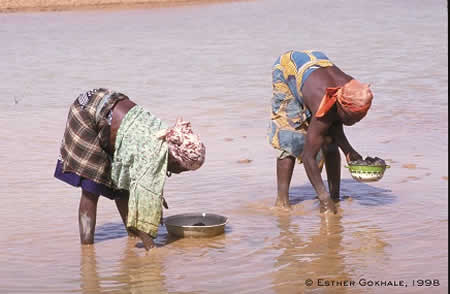
I took the picture above in Burkina Faso, a country off the tourist track in sub-Saharan Africa.
The women were collecting a chestnut-like fruit that grows under water. I had my guide halt the motorcycle and began observing this duo from afar. They stayed bent over for long periods, over 10 minutes long, coming upright only occasionally to languorously survey the landscape and then return to collecting fruit. We approached until we were close enough to begin a conversation with them, explain what I was doing, ask permission to photograph and film them, and ask my usual questions about back pain, their way of life, etc. They live with their sons, they pick water chestnuts every day for 7-9 hours, beginning around 10 am when the water is warm enough to wade in. They sell the fruit in the market so they have pocket money (their sons provide for their basic living expenses), and they wish they could sit in chairs all day. Do they have pains? Yes, by the end of the day they get sore. Does the pain stay with them? Does it travel down their legs ever? No and no. The soreness they described was what any of us might feel after using a set of muscles all day. Nothing very significant, and nothing pathological. I tried to explain to them that where I come from people sit in chairs all day and don’t have it so good…I don’t believe I got the concept across.
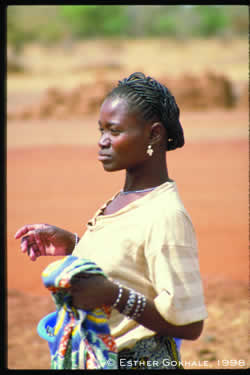
All around the world people from non-industrial cultures bend to wash, cook, clean and gather in much the way these two women do. They are active into old age and they do not suffer pathological pains the way we do. What’s striking about their form is not only that it is different from what do in modern industrial societies, but also that it is different from what we are taught to do. This last part is surprising. It’s one thing for us to be slack in our form; it’s another to be making efforts to head in the wrong direction.
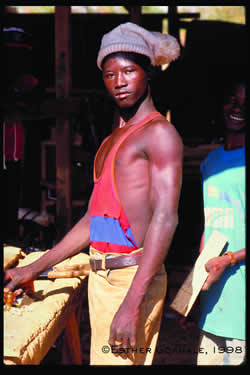
I believe we need to take a fresh look at what constitutes ideal form and body mechanics for our species. Much of what we describe as normal is informed by the average in modern culture (a poor standard by any reckoning) and by an over-reliance on our inadequate engineering assessment of our complex frames. These are flawed approaches indeed, and account for the fact that most of the popular guidelines for improving posture are, in fact, counterproductive. ‘Chin up’, ‘chest out’, ‘tuck your pelvis’, S-shaped spine, are sure-fire ways to destroy discs, impinge spinal nerves, and wear and tear all spinal structures. I suggest that until we have a much more advanced understanding of the biomechanics of our bodies, we should approach the problem anthropologically and historically. We should use well-functioning specimens of our species as models, and figure out why their ways of moving make sense. In this way, I believe that we as a society could find our way back to our natural heritage of pain-free, fully functional, and beautiful bodies.
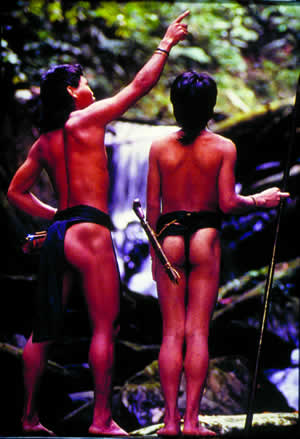
Let’s compare and contrast the posture characteristics of people in nonindustrial cultures with those most commonly found in our own modern culture.
|
Non-industrial cultures |
Industrial Cultures |
|
The pelvis is anteverted at the lumbar-sacral junction, as if with your tail behind you. |
The pelvis is held in a retroverted, or tucked under position, as if with your tail tucked between your legs. |
|
The spine is aligned in a ‘J’-shape (the bottom of the ‘J’ being a posterior sacral angle) while standing, walking and sitting. |
An “S” shape is considered the ideal shape for the spine.. |
|
The spine remains aligned in a ‘J’-shape while walking, sitting and bending. |
The spine tends to slump forward in a ‘C’ shape while sitting, standing and bending. From time to time, in a misguided effort to become upright, the spine overarches in the lumbar area. |
|
The cervical spine (neck) remains vertically stacked over the vertebrae below, with the head centrally balanced. |
The neck and chin jut forward, the weight of the head held by shortened neck muscles which arch the cervical spine. |
|
The shoulders and arms are positioned far back along the torso, with the chest open. |
The shoulders and arms drift forward, rounding the upper back and collapsing the chest. |
|
The feet and legs are externally rotated by 10 – 15 °. Feet are active and arches lifted. |
The feet and legs are parallel or internally rotated. Arches are flat and ankles pronated. |
Why Have these Postural Distortions Occurred?
Since the industrial revolution and economic migration, families have become more geographically dispersed, with parents often raising smaller families many miles away from grandparents and other extended family. This has led to a break in all sorts of cultural transmission, including the handing down of tried and tested body movement traditions. Unlike some types of learning, the kinaesthetic patterns of human movement need physical proximity and repeated visual cueing to be acquired. Traditionally, elders show the younger generation how to carry infants, who then learn how to sit, bend and walk using appropriate postural patterns that have evolved over many thousands of years. When the ancestral line is broken, the disconnected generation is more likely to be, sometimes literally, shaped by the twentieth century developments of mass media culture and mass-produced consumer goods.
The Western feel for Fashion
Probably the most significant postural shift occurred in the 1920s. A new, post–war generation redefined the ‘tall but relaxed’ traditional standing posture as stiff and passé. For the first time it became widely fashionable to tuck the pelvis and tail under and droop the shoulders forward, a position reflected in furniture such as the Mies van der Rohe chair and the ‘flapper-girl’ fashions.
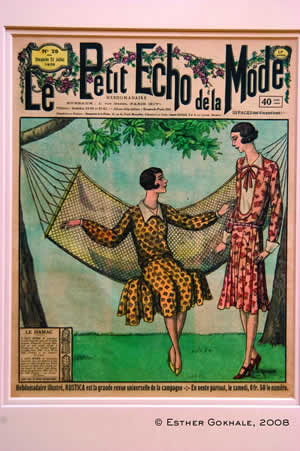
1920s ‘Flapper’ fashion encouraged tucking the pelvis.
Over successive generations this tucked posture has increasingly come to be viewed as normal. Open any fashion magazine or people-watch in any shopping mall, and that is what you find. Unfortunately, we even unwittingly undermine the healthy instincts that our infants are born with because of our modern misconceptions about the human form. For example, because we now think it is normal to tuck the pelvis under, you see babies slumped in car seats or held with the parent’s forearm tucking baby’s bottom under, which prevents her from naturally stacking her spine vertically. We just don’t realize we can ‘wire in’ these poor habits for our children.
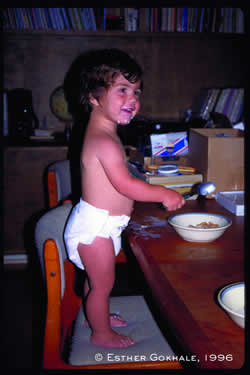
Infants naturally stand with their behinds behind them.
Modern attempts at standing with an erect posture include arching the lumbar spine in an attempt to get upright, again throwing our structure out of alignment and producing the S-shaped spine now regarded as normal. Most people in our culture will replicate these same problematic patterns in sitting, usually alternating between slumping forward and tensing the back to “sit up”. If we are unable to sit or stand well, we are also unable to walk or bend properly. Such poor patterns of posture and movement mean that the body no longer functions as a balanced and integrated whole.
Does Posture Really Matter that Much?
Everybody understands the correlation of good nutrition and exercise with wellbeing, but, even for many health and wellness professionals, posture does not yet feature on their radar. I regard postural health as something of a cultural blind spot and a neglected health issue that is every bit as important as diet, exercise, and emotional health.
If we recognize the body as a weight-bearing structure, then we can appreciate that poor alignment of the bones in gravity will result in forces that are not distributed where they should be. This causes excessive wear and tear in the joints, the growth of bone spurs (osteoarthritis) and impingements, bulging discs, and poor range of movement. Soft tissues around the bones, including the ligaments, fascia and muscles, will suffer corresponding stresses, typically becoming shorter and tighter on one side of the structure and over-stretched and weaker on the other.
Other common symptoms of poor alignment include RSI-type problems such as inflammation, tingling and numbness caused by constriction around nerves, and poor circulation from unnecessary muscular holding and bracing.
The Way Forward
Fortunately it is possible to unlearn our bad habits and restore our primal posture and movement patterns. My book, 8 Steps to a Pain-Free Back charts an effective and efficient way to help people restructure their bodies. The steps are logically explained and accompanied by high quality photographs and illustrations. They require no expensive equipment, or frequent, ongoing appointments. If you have classes near you, the best way to rediscover your natural posture is to take the Gokhale Method Foundation course. The course can be taken individually or in small groups and consists of six 1.5 hour lessons. Taking the course brings the additional benefits of teacher demonstration, hands-on help, guided repetition by students to develop muscle memory, exercises and visualization. Teachers all have prior professional experience in a field of bodywork, therapy or medicine.
Like the book, the Foundation course communicates its points clearly with inspiring photographs. Students are encouraged to make full use of the GM website, with links to their fellow students, blogs and webinars. People often experience benefits from the very first lesson, and, having completed the Foundation course, can access local classes and on-line offerings to help maintain and build on their progress.
The Gokhale Method Foundation course and Free Workshops are available in various towns and cities in the UK. See www.gokhalemethod.com for full details.
Quotes:
”The content of the course was excellent and was extremely well taught. The slides were brilliant and made it very interesting. I would highly recommend this course to my friends”
-Helen Abbot, retired Physiotherapist, Bristol UK
"Logically based, compelling, and expertly delivered….I would like to see this approach become a part of standard care. Early access to this kind of intervention could have saved me a lot of pain and grief."
- Paul R. Ehrlich PhD Bing Professor of Population Studies and President of the Center for Conservation, Stanford University, CA
Esther Gokhale and the Gokhale Method
Esther Gokhale founded her Palo Alto, California-based centre 20 years ago and has helped thousands of people get free of pain through the application of the Gokhale Method - a systematic process of restoring pain-free posture and movement. The Gokhale Method is endorsed by over 300 US doctors at the Mayo Clinic, Stanford University School of Medicine and the Palo Alto Medical Clinic. Its international following includes singer Joan Baez, tennis star Billie Jean King, author JM Coetzee, Nobel Laureate Desmond Tutu, health advisor Dr Mercola and political blogger Matt Drudge. Esther and her teachers offer courses throughout the United States, Europe, Australia, India, South America, the U.K. and Israel.
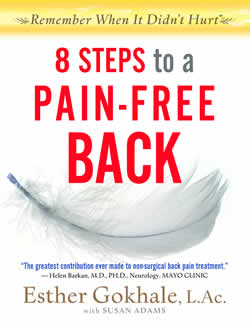
8 Steps to a Pain-Free Back
Esther Gokhale’s award-winning book, 8 Steps to a Pain-Free Back provides step-by-step instructions and demonstrations of the technique. Intelligently written and beautifully illustrated, 8 Steps to a Pain-Free Back shows readers how to overcome back pain through better posture. The book guides the reader through a series of disarmingly simple changes in posture. Lessons on sitting, walking, sleeping, and bending involve an anteverted pelvis and use the muscles to decompress the spine, support motion, protect the joints and bones, reduce stress, and improve circulation. The principles are designed to integrate easily into everyday life, while driving, sitting in a meeting, standing in line, or bending over to pick up an object.
Users are enabled not only to experience pain-relief, they will also understand why they feel so much better. The book provides convincing anthropological, developmental and historical evidence of Esther Gokhale’s fundamental claim that a return to the body’s natural posture offers the only permanent way out of back pain. Widely available in the UK and published by Lotus Publishing, www.lotuspublishing.co.uk £18.99
Comments:
-
Christine Andrew said..
I regularly give postural guidance based on this excellent book, and often recommend it to patients who are keen to support their own recovery. It clearly explains: a. what they need to do for themselves posturally to avoid back pain, and b. that it is exactly how they are sitting, bending, standing and lying in daily life that has the greatest impact on their musculo-skeletal system. I have also received very positive reports from patients who have recently chosen to take the course.